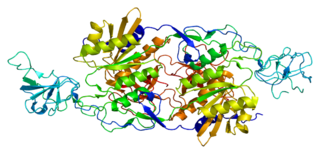Neuronal acetylcholine receptor subunit beta-3 is a protein that in humans is encoded by the CHRNB3 gene. [5] [6] This gene has been identified as a candidate for predisposition to tobacco dependence.
Neuronal acetylcholine receptor subunit beta-3 is a protein that in humans is encoded by the CHRNB3 gene. [5] [6] This gene has been identified as a candidate for predisposition to tobacco dependence.

Nicotinic acetylcholine receptors, or nAChRs, are receptor polypeptides that respond to the neurotransmitter acetylcholine. Nicotinic receptors also respond to drugs such as the agonist nicotine. They are found in the central and peripheral nervous system, muscle, and many other tissues of many organisms. At the neuromuscular junction they are the primary receptor in muscle for motor nerve-muscle communication that controls muscle contraction. In the peripheral nervous system: (1) they transmit outgoing signals from the presynaptic to the postsynaptic cells within the sympathetic and parasympathetic nervous system, and (2) they are the receptors found on skeletal muscle that receive acetylcholine released to signal for muscular contraction. In the immune system, nAChRs regulate inflammatory processes and signal through distinct intracellular pathways. In insects, the cholinergic system is limited to the central nervous system.
Autosomal dominant nocturnal frontal lobe epilepsy is an epileptic disorder that causes frequent violent seizures during sleep. These seizures often involve complex motor movements, such as hand clenching, arm raising/lowering, and knee bending. Vocalizations such as shouting, moaning, or crying are also common. ADNFLE is often misdiagnosed as nightmares. Attacks often occur in clusters and typically first manifest in childhood. There are four known loci for ADNFLE, three with known causative genes. These genes, CHRNA4, CHRNB2, and CHRNA2, encode various nicotinic acetylcholine receptor α and β subunits.

The muscarinic acetylcholine receptor M4, also known as the cholinergic receptor, muscarinic 4 (CHRM4), is a protein that, in humans, is encoded by the CHRM4 gene.

Neuronal acetylcholine receptor subunit alpha-7, also known as nAChRα7, is a protein that in humans is encoded by the CHRNA7 gene. The protein encoded by this gene is a subunit of certain nicotinic acetylcholine receptors (nAchR).

Neuronal acetylcholine receptor subunit alpha-4, also known as nAChRα4, is a protein that in humans is encoded by the CHRNA4 gene. The protein encoded by this gene is a subunit of certain nicotinic acetylcholine receptors (nAChR). Alpha4-containing nAChRs appear to play a crucial role in the addictive response to nicotine..

Neuronal acetylcholine receptor subunit beta-2 is a protein that in humans is encoded by the CHRNB2 gene.

Neuronal acetylcholine receptor subunit alpha-3, also known as nAChRα3, is a protein that in humans is encoded by the CHRNA3 gene. The protein encoded by this gene is a subunit of certain nicotinic acetylcholine receptors (nAchR). Research with mecamylamine in animals has implicated alpha-3-containing nAChRs in the abusive and addictive properties of ethanol.

Neuronal acetylcholine receptor subunit alpha-1, also known as nAChRα1, is a protein that in humans is encoded by the CHRNA1 gene. The protein encoded by this gene is a subunit of certain nicotinic acetylcholine receptors (nAchR).

Neuronal acetylcholine receptor subunit beta-4 is a protein that in humans is encoded by the CHRNB4 gene.

Voltage-dependent L-type calcium channel subunit beta-1 is a protein that in humans is encoded by the CACNB1 gene.

Neuronal acetylcholine receptor subunit alpha-5, also known as nAChRα5, is a protein that in humans is encoded by the CHRNA5 gene. The protein encoded by this gene is a subunit of certain nicotinic acetylcholine receptors (nAchR).

Neuronal acetylcholine receptor subunit alpha-2, also known as nAChRα2, is a protein that in humans is encoded by the CHRNA2 gene. The protein encoded by this gene is a subunit of certain nicotinic acetylcholine receptors (nAchR).

Acetylcholine receptor subunit delta is a protein that in humans is encoded by the CHRND gene.

Acetylcholine receptor subunit beta is a protein that in humans is encoded by the CHRNB1 gene.

Gamma-aminobutyric acid receptor subunit rho-2 is a protein that in humans is encoded by the GABRR2 gene.

Glycine receptor subunit beta is a protein that in humans is encoded by the GLRB gene.

Neuronal acetylcholine receptor subunit alpha-9, also known as nAChRα9, is a protein that in humans is encoded by the CHRNA9 gene. The protein encoded by this gene is a subunit of certain nicotinic acetylcholine receptors (nAchR).

Cholinergic receptor, nicotinic, alpha 6, also known as nAChRα6, is a protein that in humans is encoded by the CHRNA6 gene. The CHRNA6 gene codes for the α6 nicotinic receptor subunit that is found in certain types of nicotinic acetylcholine receptors found primarily in the brain. Neural nicotinic acetylcholine receptors containing α6 subunits are expressed on dopamine-releasing neurons in the midbrain, and dopamine release following activation of these neurons is thought to be involved in the addictive properties of nicotine. Due to their selective localisation on dopaminergic neurons, α6-containing nACh receptors have also been suggested as a possible therapeutic target for the treatment of Parkinson's disease. In addition to nicotine, research in animals has implicated alpha-6-containing nAChRs in the abusive and addictive properties of ethanol, with mecamylamine demonstrating a potent ability to block these properties.

Pozanicline is a drug developed by Abbott, that has nootropic and neuroprotective effects. Animal studies suggested it useful for the treatment of ADHD and subsequent human trials have shown ABT-089 to be effective for this application. It binds with high affinity subtype-selective to the α4β2 nicotinic acetylcholine receptors and has partial agonism to the α6β2 subtype, but not the α7 and α3β4 subtypes familiar to nicotine. It has particularly low tendency to cause side effects compared to other drugs in the class, making it an exciting candidate for clinical development.
The alpha-3 beta-2 nicotinic receptor, also known as the α3β2 receptor, is a type of nicotinic acetylcholine receptor, consisting of α3 and β2 subunits.
This article incorporates text from the United States National Library of Medicine, which is in the public domain.